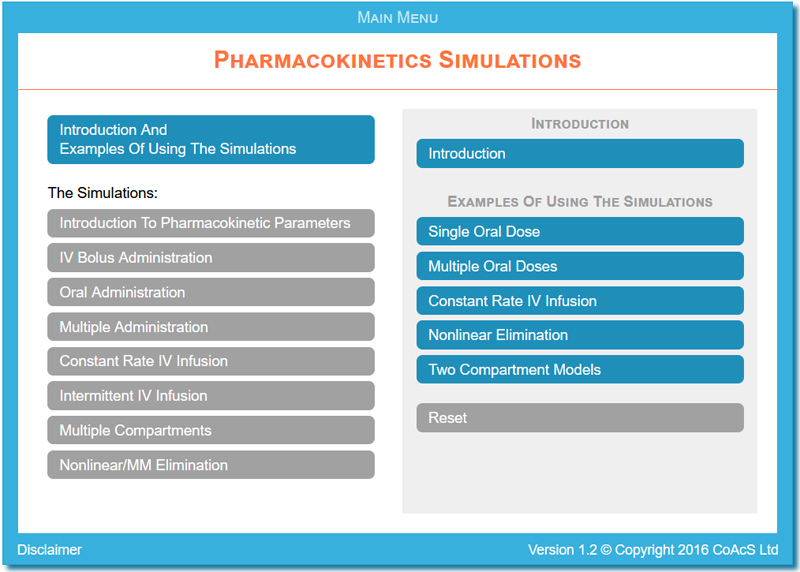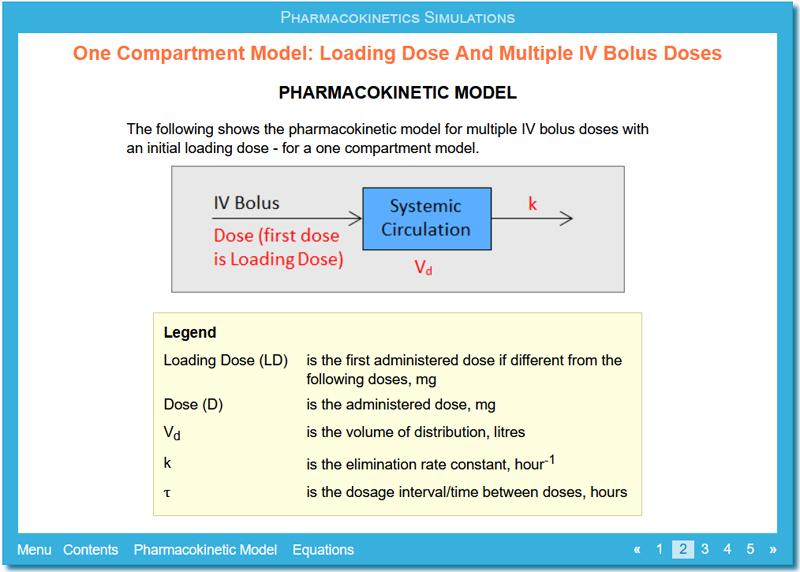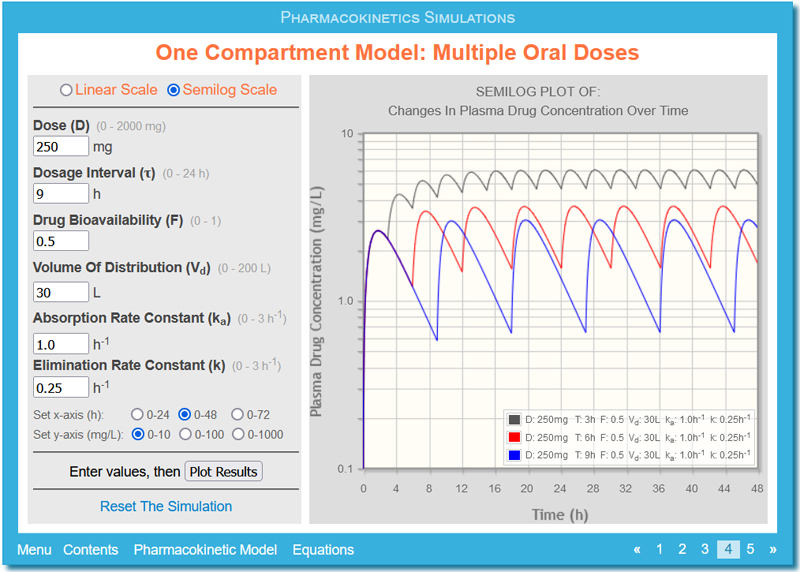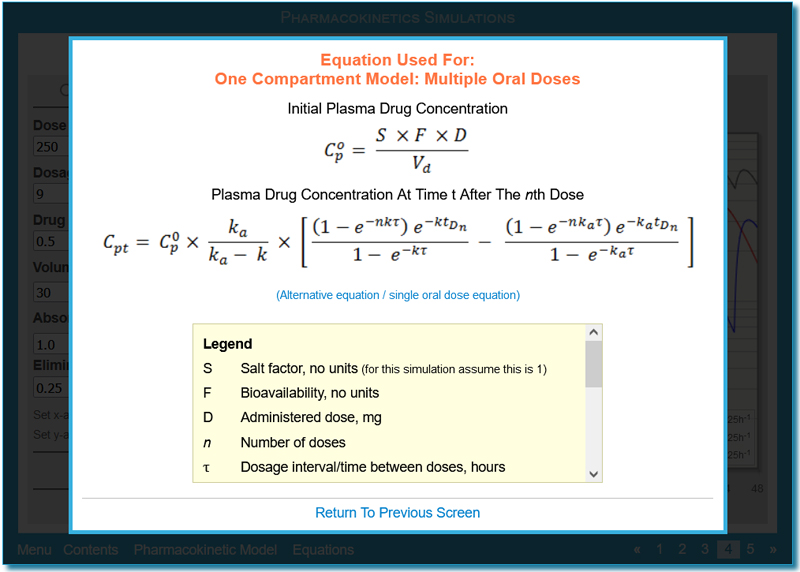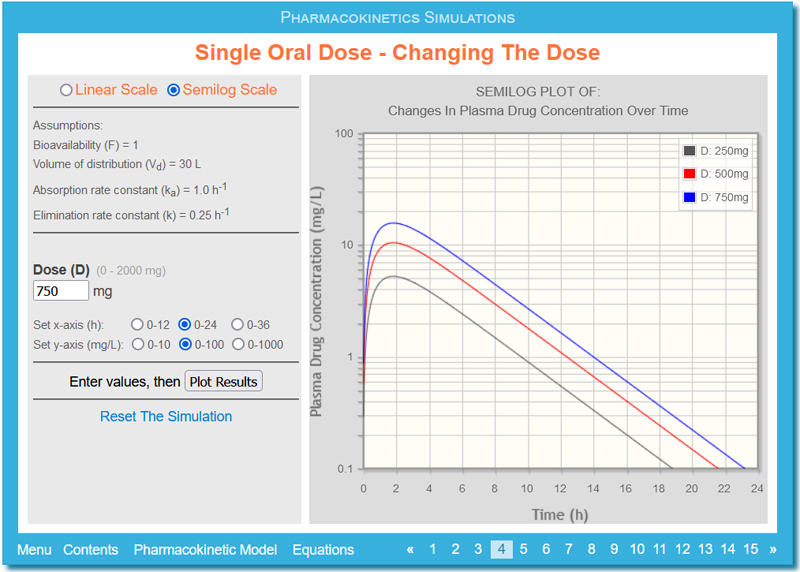Pharmacokinetics Simulations
The primary objective of the package, Pharmacokinetics Simulations, is to teach the basic principles of pharmacokinetics through computer simulations.
Simulation of the plasma drug concentration-time profile is a valuable tool to understand the basic pharmacokinetic principles and to appreciate the interplay of various pharmacokinetic parameters.
In this package, a user can select a pharmacokinetic model, adjust one or more pharmacokinetic parameters and evaluate how changes in the parameter(s) affect the resulting plasma drug concentration-time profile. Results can be plotted either on a linear scale or on a semilog scale; the user can easily switch between linear and semilog scales.
Information about the pharmacokinetic model and equation(s) used for the calculations in a simulation can be seen at any point when working through a simulation.
Product Code: COP004
Price: £300 p.a. (per institution)
Pharmacokinetics Simulations covers the following:
- IV bolus drug administration
- Oral drug administration
- Constant rate IV infusions
- Intermittent IV infusions
- Single and multiple administration
- Loading doses
- Linear and nonlinear drug elimination
- One and two compartment pharmacokinetic models
The main pharmacokinetic parameters covered are:
- Elimination rate constant
- Volume of distribution
- Half-life
- Total Body Clearance
- Area Under The Concentration-Time Curve
- Bioavailability
- First Order Absorption Rate Constant
- Dose
CONTENTS OF THE PACKAGE
Pharmacokinetics Simulations consists of the following sections and activities:
Introductory Section: Introduction And Examples Of Using The Simulations
Introduction
- Introduction
Examples Of Using The Simulations
- Single Oral Dose
- Multiple Oral Doses
- Constant Rate IV Infusion
- Nonlinear Elimination
- Two Compartment Models
Main Section: The Simulations
Section 1: Introduction To Pharmacokinetic Parameters
- Elimination Rate Constant (k)
- Volume Of Distribution (Vd)
- Half-Life (t1/2)
- Total Body Clearance (TBC)
- Area Under The Concentration-Time Curve (AUC)
- Bioavailability (F)
- First Order Absorption Rate Constant (ka)
- Dose (D)
Section 2: IV Bolus Administration
One Compartment Models
- Single IV Bolus Dose
- Multiple IV Bolus Doses
- Loading Dose And Multiple Doses
Two Compartment Models
- Single IV Bolus Dose
- Multiple IV Bolus Doses
- Loading Dose And Multiple Doses
Section 3: Oral Administration
One Compartment Models
- Single Oral Dose
- Multiple Oral Doses
- Loading Dose And Multiple Doses
Two Compartment Models
- Single Oral Dose
- Multiple Oral Doses
- Loading Dose And Multiple Doses
Section 4: Multiple Administration
One Compartment Models
- Multiple IV Bolus Doses
- Multiple Oral Doses
Two Compartment Models
- Multiple IV Bolus Doses
- Multiple Oral Doses
MM Elimination/Nonlinear Elimination
- Multiple Oral Doses
Section 5: Constant Rate IV Infusion
One Compartment Models
- Constant Rate IV Infusion
- Loading Dose And Constant Rate IV Infusion
Two Compartment Models
- Constant Rate IV Infusion
- Loading Dose And Constant Rate IV Infusion
Section 6: Intermittent IV Infusion
One Compartment Models
- Single Short IV Infusion
- Multiple Short IV Infusions
- Loading Dose And Multiple Short IV Infusions
Two Compartment Models
- Single Short IV Infusion
- Multiple Short IV Infusions
- Loading Dose And Multiple Short IV Infusions
Section 7: Multiple Compartments
Two Compartment Models
- Single IV Bolus Dose
- Multiple IV Bolus Doses
- Single Oral Dose
- Multiple Oral Doses
- Constant Rate IV Infusion
- Loading Dose And Constant Rate IV Infusion
Central And Peripheral Profiles
- Single IV Bolus Dose
- Multiple IV Bolus Doses
Section 8: Nonlinear/MM Elimination
- Single IV Bolus Dose
- Single Oral Dose
- Multiple Oral Doses
- Single IV Bolus Dose: Nonlinear Elimination In Presence OF Competitive Inhibitor
The package allows users to simulate the effects of adjusting one or more pharmacokinetic parameters for a range of pharmacokinetic models.
Pre-requisites: Users should have a basic knowledge of pharmacokinetic parameters.
Audience: Undergraduate pharmacy and pharmacology students; people working in the medical profession for whom a knowledge of basic pharmacokinetic principles and pharmacokinetic parameter interplay would be useful.
Time to complete: The package contains over 40 simulations; time to complete the package is dependent on how many simulations a user works through and how long the user spends in a single simulation.
There are currently no reviews available for this package.
Share this page
Related resources
Main CoAcS website

The main CoAcS website explains more about the areas in which we operate including:
- pharmacy education
- healthcare applications to hospitals and pharma
- bespoke software
- pharmaceutical plant design and consultancy
College of Pharmacy (CoP)
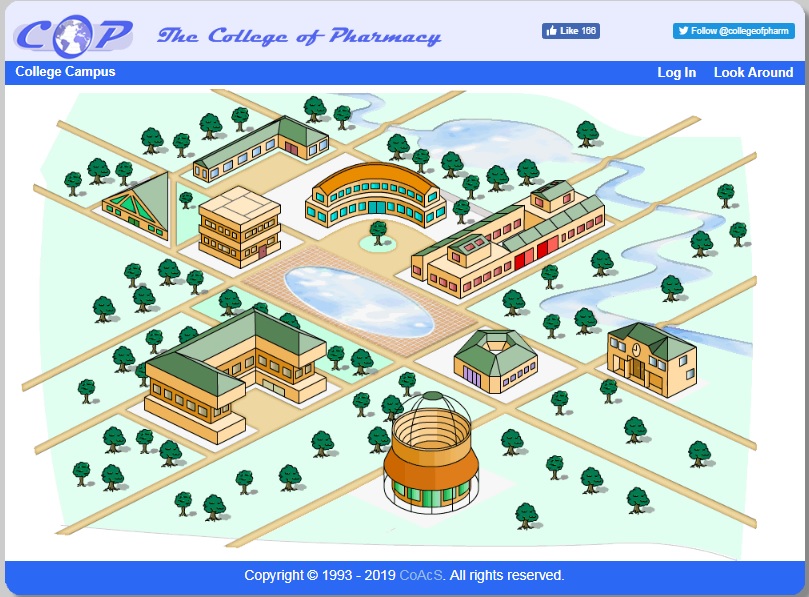
The College of Pharmacy (CoP) website is the gateway to all of our CAL packages. Besides the subscribed pharmacy learning materials, you will also have free access to the:
- museum – containing images of historical documents and pharmacy artifacts
- library – with listings of the latest pharmacy journals and other publications
- lecture theatre – access to many diverse university presentations
- herb garden – to promote the understanding of herbs and medicinal plants and their place in traditional and modern pharmacy
Pharmaceutical Press agents
We are exclusive agents in the Middle East for the Pharmaceutical Press (the publishing arm of the Royal Pharmaceutical Society). We are able to supply countries with invaluable online resources – such as ‘Medicines Complete’. Many other titles are available including:
- the British National Formulary (BNF)
- Stockley’s Drug Interactions
- Martindale’s Complete Drug Reference
Please contact us directly if you wish to arrange a subscription.
